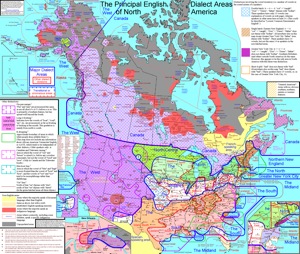Dialect
Etymology
Middle French dialecte, from Latin dialectus, from Greek dialektos conversation, dialect, from dialegesthai to converse — more at dialogue
- Date: 1577
Definitions
- 1 a : a regional variety of language distinguished by features of vocabulary, grammar, and pronunciation from other regional varieties and constituting together with them a single language <the Doric dialect of ancient Greek>
- b : one of two or more cognate languages <French and Italian are Romance dialects>
- c : a variety of a language used by the members of a group <such dialects as politics and advertising — Philip Howard>
- d : a variety of language whose identity is fixed by a factor other than geography (as social class) <spoke a rough peasant dialect>
- 2 : manner or means of expressing oneself : phraseology
Description
The term dialect (from the Greek Language word dialektos, Διάλεκτος) is used in two distinct ways, even by linguists. One usage refers to a variety of a language that is characteristic of a particular group of the language's speakers.[1] The term is applied most often to regional speech patterns, but a dialect may also be defined by other factors, such as social class.[2] A dialect that is associated with a particular social class can be termed a sociolect; a regional dialect may be termed a regiolect or topolect. The other usage refers to a language socially subordinate to a regional or national standard language, often historically cognate to the standard, but not a variety of it or in any other sense derived from it. This more precise usage enables distinguishing between varieties of a language, such as the French spoken in Nice, France, and local languages distinct from the superordinate language, e.g. Nissart, the traditional native Romance language of Nice, known in French as Niçard.
A dialect is distinguished by its vocabulary, grammar, and pronunciation (phonology, including prosody). Where a distinction can be made only in terms of pronunciation, the term accent is appropriate, not dialect. Other speech varieties include: standard languages, which are standardized for public performance (for example, a written standard); jargons, which are characterized by differences in lexicon (vocabulary); slang; patois; pidgins or argots. The particular speech patterns used by an individual are termed an idiolect.
Standard and non-standard dialect
A standard dialect (also known as a standardized dialect or "standard language") is a dialect that is supported by institutions. Such institutional support may include government recognition or designation; presentation as being the "correct" form of a language in schools; published grammars, dictionaries, and textbooks that set forth a "correct" spoken and written form; and an extensive formal literature that employs that dialect (prose, poetry, non-fiction, etc.). There may be multiple standard dialects associated with a single language. For example, Standard American English, Standard Indian English, Standard Australian English, and Standard Philippine English may all be said to be standard dialects of the English language.
A nonstandard dialect, like a standard dialect, has a complete vocabulary, grammar, and syntax, but is not the beneficiary of institutional support. An example of a nonstandard English dialect is Southern American English. The Dialect Test was designed by Joseph Wright to compare different English dialects with each other.[1]
